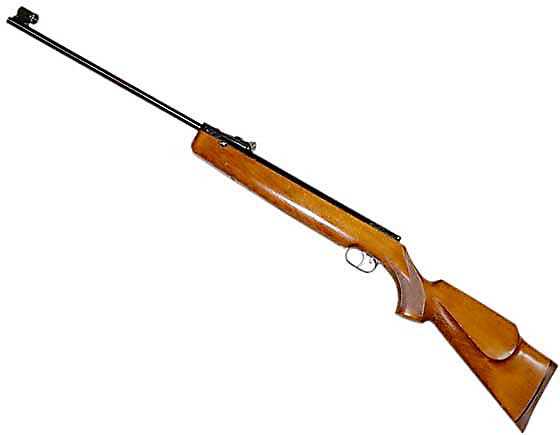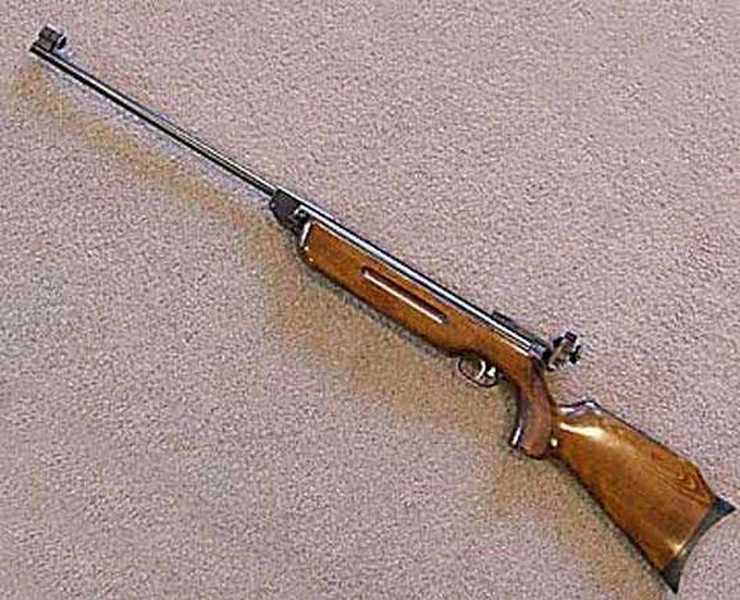by Tom Gaylord
Writing as B.B. Pelletier
This report covers:
- The beginning
- What is a lube tune?
- The rifle
- Initial impressions
- The plan
- History
- Summary
When talking about guns that become favorites, they say the airgun picks the shooter. Actually they say that about a lot of hobbies. This R8 certainly picked me — and then steamrolled me into submission!
The beginning
I was at the dinner/reception the evening before the 2017 Findlay airgun show last weekend when Tyler Patner and Kristen Coss from Pyramyd Air walked in. I went over to say hello and Tyler asked me a question about an old airgun they had brought to sell. Actually they brought about 50 old guns and a lot of vintage Beeman pellets that they received in the purchase of a dealership. I asked to see the list and noticed a Beeman R8. That is an airgun I have never directly tested, though my Tyrolean breakbarrel that’s one of my all-time favorites started out as an R8. That one was tuned, and I always wondered what a standard R8 would be like, so I cut a deal for this rifle, sight unseen.
The next morning at the show we consummated the deal and I had a new/old R8. It was prettier than described, so I was pleased. What I didn’t know was I had just taken the leash of a lightning bolt!
Image may be NSFW.
Clik here to view.
My Beeman R8 looks like a baby R1.
The rifle remained hidden away in a gun case for the rest of the show, but when anyone asked me if I had found anything interesting, I stupidly mentioned it. That lead to a number of offers to buy it outright — offers that went beyond just money. It turns out that a lot of vintage airgunners (with vintage referring to the person this time, not the gun) know about the R8 and want one. I could have sold that rifle for a considerable profit perhaps five times throughout the course of the show.
All I wanted to do was test it and compare a stock R8 to my custom one, but the incredible interest in the gun awakened my own curiosity. And, as I discovered last Thursday, this R8 is not stock. Someone has been inside and has at least given it a lube tune.
What is a lube tune?
A lube tune is just a lubrication of a spring gun with the objective of smoothing the powerplant. No additional power is gained this way, unless some of the powerplant parts are also changed. The piston seal, breech seal and mainspring are the primary parts that would possibly need changing.
I won’t know what has been done until the powerplant is completely disassembled and examined. The breech seal that I can see appears to be stock and also in good condition. I intend to use the new Air Venturi Rail Lock spring compressor for this disassembly. You will get to see all the parts as they come out of the rifle, and I will give you a detailed description of all that I see and do.
The rifle
The Beeman R8 is a conventional breakbarrel spring rifle that’s on the small side of an adult airgun. The length is 43-inches and the rifle weighs about 7.2 lbs. The barrel is 18.3-inches long. The pull (length from the trigger to the end of the butt) is 14-inches. The beech stock has a cheekpiece on the right side and the rifle was also offered in a left-hand version that differed only in the stock. The pistol grip is checkered on both sides, and there is a palm swell on the right side. The forearm is smooth.
The trigger is a sporting Rekord that’s found in many other Weihrauch sporting rifles. The safety is automatic and comes on every time the rifle is cocked. If it is taken off, the barrel must be broken again to reset it.
My last comment about the rifle will be that it is just right. It’s not too heavy, not too large and certainly not too hard to cock. The firing sysle is dead calm on the rifle I’m testing, but that may not hold true for a gun that hasn’t been tuned. Perhaps a reader who owns one can comment?
Initial impressions
I didn’t get a chance to shoot this rifle until I returned home from the show a week ago. When I cocked it the first time I was surprised by how easy it is! I will report on that effort for you in Part 2. As it now stands I think it’s about the same as my Tyrolean.
Then I shot it and got surprise number 2. The firing cycle is just as smooth as the Tyrolean’s! Just from this I felt the airgun had to have been tuned, but I waited to tell you until I saw the proof that I showed you in the report on the Rail Lock Compressor. There is more grease inside than I’ve even seen in a Weihrauch air rifle, plus the grease is both thicker and tackier than the grease Weihrauch uses. Trust me on that, for I have seen the insides of many Weihrach airguns.
This is not a stock Beeman R8. But what has been done to it? Does anything still need doing that could make it shoot better? I enjoy the way it cocks and shoots at present, but I don’t want to get that through excessive grease, alone. So we may be in for a long tuning session.
The plan
Everyone wants to know how the rifle performs right now. So, that’s the next step. I will do a velocity test, followed by an accuracy test. Those tests will tell us where the rifle is. We can compare that to the Tyrolean’s performance, and it will also serve as the base against any tuning I might do. I want this rifle to come out of this testing and tuning better than it went in — otherwise, what’s the point? If grease, alone, makes it this good, why not just leave it as is and be satisfied?
This R8 has a front globe sight that accepts interchangeable inserts, and there is a square post in there right now. The accuracy should not improve from tuning. Accuracy lives mostly in the barrel and, to a lesser extent, in the stock bedding. The bedding seems good as is.
I told you that the forearm is held to the action by a single screw. In that photo you also saw the articulated cocking link that allows the stock’s cocking slot to be cut short. That makes the stock stiffer, which reduces vibration. Beeman made a big thing of this in his catalog when the R8 was launched, along with the R7, back in 1982. He put that into the R7 description, but mentioned in the R8 description that the reader should also read the R7 description, because some of it applied to both rifles.
Image may be NSFW.
Clik here to view.
This photo of the forearm stock screw also shows the two-piece articulated cocking link. That design allows for a shorter cocking slot in the stock.
The Rekord trigger is currently adjusted very light — perhaps too light for my taste. I’ll measure that for you in Part 2. I might have to stiffen the return spring resistance and make stage two of the trigger pull more definite.
History
The Beeman R8 is based on Weihrauch’s older design of the HW 50S — the one that had a 25mm spring tube. The current HW50S spring tube is 26mm and is a different gun. That old rifle was legendary for its smoothness, and, besides my Tyrolean R8, I actually own another example of that rifle. It’s my HW55SF.
Of all the HW55 target rifles, the HW55SF (also SM and ST) is the one that doesn’t have a barrel lock! It’s really an HW50 that has a heavier barrel, target stock, target sights and the special target version of the Rekord trigger.
Image may be NSFW.
Clik here to view.
The HW55SF is not a standard HW55. It is based on the HW50 and does not have the barrel lock.
As I mentioned, the R7 and R8 were launched at the same time. The R7 was a Beemanized (that really means a more classic style stock with a longer forearm) HW30S, while the R8 was the HW50S. The S stands for rifles that have the Rekord trigger. When they were first offered the R7 sold for $159.50, and the R8 went for $249.50. The Beeman R1 was priced at $329.50 at this same time, which is April of 1983.
The Blue Book of Airguns says the R8 ran from 1983 until 1996, but I have a Beeman catalog from 1982 in which it is advertised. So — late ’82/early ’83 is about the start.
Summary
That’s all for today. This will be a conventional test until I tear the rifle apart. Then we will see where it goes.